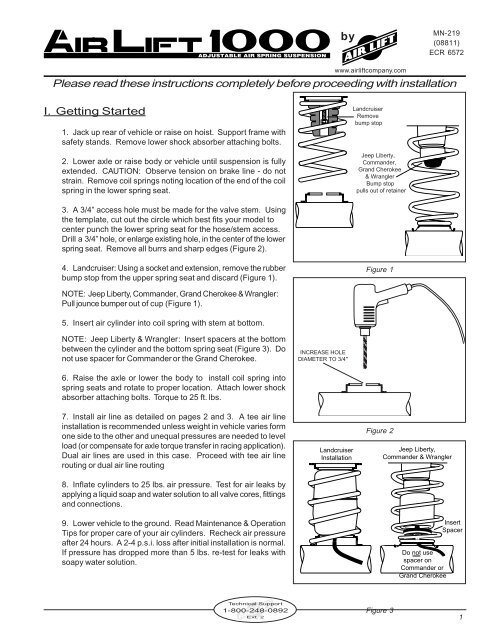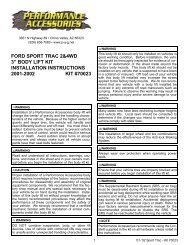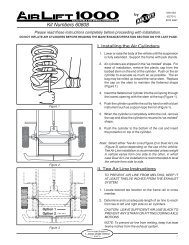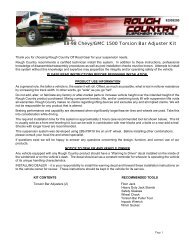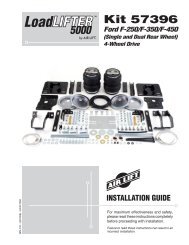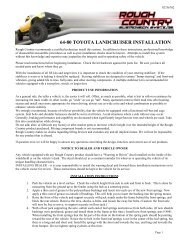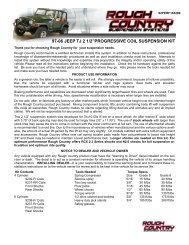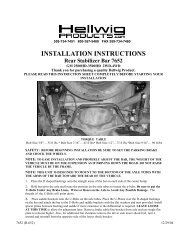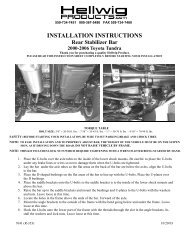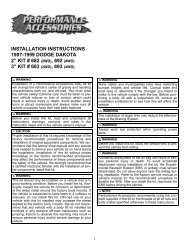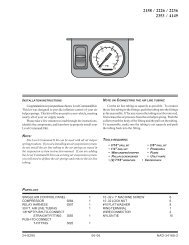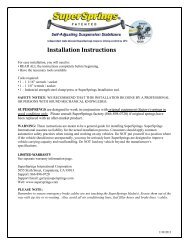Please read these instructions completely before ... - SD Truck Springs
Please read these instructions completely before ... - SD Truck Springs
Please read these instructions completely before ... - SD Truck Springs
Create successful ePaper yourself
Turn your PDF publications into a flip-book with our unique Google optimized e-Paper software.
yMN-219(08811)ECR 6572www.airliftcompany.com<strong>Please</strong> <strong>read</strong> <strong>these</strong> <strong>instructions</strong> <strong>completely</strong> <strong>before</strong> proceeding with installationI. Getting Started1. Jack up rear of vehicle or raise on hoist. Support frame withsafety stands. Remove lower shock absorber attaching bolts.2. Lower axle or raise body or vehicle until suspension is fullyextended. CAUTION: Observe tension on brake line - do notstrain. Remove coil springs noting location of the end of the coilspring in the lower spring seat.LandcruiserRemovebump stopJeep Liberty,Commander,Grand Cherokee& WranglerBump stoppulls out of retainer3. A 3/4” access hole must be made for the valve stem. Usingthe template, cut out the circle which best fits your model tocenter punch the lower spring seat for the hose/stem access.Drill a 3/4” hole, or enlarge existing hole, in the center of the lowerspring seat. Remove all burrs and sharp edges (Figure 2).4. Landcruiser: Using a socket and extension, remove the rubberbump stop from the upper spring seat and discard (Figure 1).Figure 1NOTE: Jeep Liberty, Commander, Grand Cherokee & Wrangler:Pull jounce bumper out of cup (Figure 1).5. Insert air cylinder into coil spring with stem at bottom.NOTE: Jeep Liberty & Wrangler: Insert spacers at the bottombetween the cylinder and the bottom spring seat (Figure 3). Donot use spacer for Commander or the Grand Cherokee.INCREASE HOLEDIAMETER TO 3/4"6. Raise the axle or lower the body to install coil spring intospring seats and rotate to proper location. Attach lower shockabsorber attaching bolts. Torque to 25 ft. lbs.7. Install air line as detailed on pages 2 and 3. A tee air lineinstallation is recommended unless weight in vehicle varies formone side to the other and unequal pressures are needed to levelload (or compensate for axle torque transfer in racing application).Dual air lines are used in this case. Proceed with tee air linerouting or dual air line routing8. Inflate cylinders to 25 lbs. air pressure. Test for air leaks byapplying a liquid soap and water solution to all valve cores, fittingsand connections.9. Lower vehicle to the ground. Read Maintenance & OperationTips for proper care of your air cylinders. Recheck air pressureafter 24 hours. A 2-4 p.s.i. loss after initial installation is normal.If pressure has dropped more than 5 lbs. re-test for leaks withsoapy water solution.LandcruiserInstallationFigure 2Jeep Liberty,Commander & WranglerDo not usespacer onCommander orGrand CherokeeInsertSpacerTechnical Support1-800-248-0892Ext. 2Figure 31
ACII. Tee Air Line RoutingBTee air line installation recommended unless weight in vehiclevaries from one side to the other and unequal pressures areneeded to level the load. Dual air lines are used in this case.TO PREVENT AIR LINE FROM MELTING, KEEP IT AT LEASTEIGHT INCHES FROM EXHAUST SYSTEM.A. Locate desired tee location on the frame rail or cross member.Use this procedure for all air line connections:A. Slide the air clamp onto the air line.B. Push the air line over the barbed stem.C. Compress the ears on the air line clampwith pliers and slide it forward to fully coverthe barbed section.Figure 4B. Determine and cut adequate length of air line to reach fromtee to left and right side on air cylinders.CAUTION: LEAVE SUFFICIENT AIR LINE SLACK TO PREVENTANY STRAIN ON FITTING DURING AXLE MOTIONS.C. Slide air line clamp onto the air line. Push the air line overone side of the tee until all the barbs are covered. Repeat procedurefor other leg of tee.D. With pliers slide the air line clamp forward until it fully coversthe barbed section. Repeat for other leg of tee (Figure 4).E. Route along cross member and either lower control arm orupper spring seat to air cylinder.F. Insert air line through lower spring seat then slide on air lineclamp.G. Push the air line onto the stem, covering all the barbs. Withpliers slide the air line clamp upward until it fully covers the barbedsection (Figure 5).Figure 5H. Push the remaining air line over the last fitting on tee androute along frame to desired inflation valve location (Figure 6).Attach with plastic straps or wire.I. Select a location for inflation valve in the gas cap well, thetrunk, rear bumper, fender flange or behind the license plate,assuring that the valve will be protected and accessible with anair hose (Figure 6).J. Drill a 5/16” hole for inflation valve and mount as in illustration(Figure 8). Rubber washer is for outside weather seal.K. Slide air line clamp over the air line. Push air line onto fittingcovering all barbs, with pliers slide the air line clamp forward untilit fully covers the barbed section (Figure 6).Figure 6L. Raise axle or lower body until air cylinders lightly touch theupper and lower spring seat.M. Check TAILPIPE clearance and insure that it is at least 2-3inches from air cylinder. If necessary, loosen clamps and rotateor move to obtain additional clearance. If heat shield is provided,install it.NOTE: Attach shock absorbers if removed earlier in theinstallation.2Technical Support1-800-248-0892Ext. 2
IV. Maintenance and OperationsMinimum Air PressureMaximum Air Pressure5 p.s.i. 35 p.s.i.Failure to maintain correct minimum pressure (or pressure proportional to load), bottomingout, over-extension, or rubbing against another component will void the warranty.By following <strong>these</strong> steps, vehicle owners will obtain the longest life and best results from their airsprings.Maintenance1. Check the air pressure weekly.2. Always maintain at least 5 p.s.i. air pressure to prevent chafing or coil pinch.3. If you develop an air leak in the system, use a soapy water solution to check all air line connections and the inflationvalve core <strong>before</strong> removing the cylinder.Operating Tips1. Inflate your air springs to 35 p.s.i. <strong>before</strong> adding the payload. This will allow the air cylinder to properly mesh with thecoil spring. After vehicle is loaded, adjust your air pressure (down) to level with the vehicle and for ride comfort.2. When you are carrying a payload it will be helpful to increase the tire inflation pressure in proportion to any overloadcondition. We recommend a 2 p.s.i. increase above normal (not to exceed tire manufacturers maximum) for each100 lbs. additional load on the axle.4Thank you for purchasing Air Lift ProductsMailing Address:Street Address:AIR LIFT COMPANYAIR LIFT COMPANYP.O. Box 801672727 Snow Rd.Lansing, MI 48908-0167 Lansing, MI 48917Local Phone: (517) 322-2144Fax: (517) 322-0240For Technical Assistance call 1-800-248-0892Technical Support1-800-248-0892“The Choice of the Professional Ext. 2Installer” 10 10Printed in the USA
Product Use InformationFrequently asked questionsQ. Will installing air springs increase the weight ratings of a vehicle?No. Adding air springs will not change the weight ratings (GAWR, GCWR and/or GVWR) of a vehicle. Exceeding theGVWR is dangerous and voids the Air Lift warranty.Q. Is it necessary to keep air in the air springs at all time and how much pressure will they need?The minimum air pressure should be maintained at all times. The minimum air pressure keeps the air spring in shape,ensuring that it will move throughout its travel without rubbing or wearing on itself.Q. Is it necessary to add a compressor system to the air springs?No. Air pressure can be adjusted with any type of compressor as long as it can produce sufficient pressure to servicethe springs. Even a bicycle tire pump can be used, but it’s a lot of work.Q. How long should air springs last?If the air springs are properly installed and maintained they can last indefinitely.Q. Will raising the vehicle on a hoist for service work damage the air springs?No. The vehicle can be lifted on a hoist for short-term service work such as tire rotation or oil changes. However, ifthe vehicle will be on the hoist for a prolonged period of time, support the axle with jack stands in order to take thetension off of the air springs.Tuning the air pressurePressure determination comes down to three things — level vehicle, ride comfort, and stability.1. Level vehicleIf the vehicle’s headlights are shining into the trees or the vehicle is leaning to one side, then it is not level (fig. 1).Raise the air pressure to correct either of <strong>these</strong> problems and level the vehicle.2. Ride comfortIf the vehicle has a rough and harsh ride it may be due to either too much pressure or not enough (fig. 2). Try differentpressures to determine the best ride comfort.3. StabilityStability translates into safety and should be the priority, meaning the driver may need to sacrifice a perfectly leveland comfortable ride. Stability issues include roll control, bounce, dive during braking and sponginess (fig. 3). Tuningout <strong>these</strong> problems usually requires an increase in pressure.Bad headlight aimfig. 1 fig. 2Sway and body rollRough ridefig. 3Continued on pg. 2
Continued from pg. 1Guidelines for adding air:1. Start with the vehicle level or slightly above.2. When in doubt, always add air.3. For motorhomes, start with 50-100 PSI in the rear because it can be safely assumed that it is heavily loaded.4. If the front of the vehicle dives while braking, increase the pressure in the front air bags, if equipped.5. If it is ever suspected that the air bags have bottomed out, increase the pressure (fig. 4).6. Adjust the pressure up and down to find the best ride.7. If the vehicle rocks and rolls, adjust the air pressure to reduce movement.8. It may be necessary to maintain different pressures on each side of the vehicle. Loads such as water, fuel,and appliances will cause the vehicle to be heavier on one side (fig. 5). As much as a 50 PSI difference is notuncommon.Bottoming out fig. 4 Unlevel Levelfig. 5Warranty and Returns PolicyAir Lift Company warrants its products, for the time periods listed below, to the original retail purchaser against manufacturing defects whenused on catalog-listed applications on cars, vans, light trucks and motorhomes under normal operating conditions for as long as Air Liftmanufactures the product. The warranty does not apply to products that have been improperly applied, improperly installed, used in racingor off-road applications, used for commercial purposes, or which have not been maintained in accordance with installation <strong>instructions</strong>furnished with all products. The consumer will be responsible for removing (labor charges) the defective product from the vehicle andreturning it, transportation costs prepaid, to the dealer from which it was purchased or to Air Lift Company for verification.Air Lift will repair or replace, at its option, defective products or components. A minimum $10.00 shipping and handling charge will apply toall warranty claims. Before returning any defective product, you must call Air Lift at (800) 248-0892 in the U.S. and Canada (elsewhere, (517)322-2144) for a Returned Materials Authorization (RMA) number. Returns to Air Lift can be sent to: Air Lift Company • 2727 Snow Road •Lansing, MI • 48917.Product failures resulting from abnormal use or misuse are excluded from this warranty. The loss of use of the product, loss of time,inconvenience, commercial loss or consequential damages is not covered. The consumer is responsible for installation/reinstallation (laborcharges) of the product. Air Lift Company reserves the right to change the design of any product without assuming any obligation to modifyany product previously manufactured.This warranty gives you specific legal rights and you may also have other rights that vary from state-to-state. Some states do not allowlimitations on how long an implied warranty lasts or allow the exclusion or limitation of incidental or consequential damages. The abovelimitation or exclusion may not apply to you. There are no warranties, expressed or implied including any implied warranties of merchantabilityand fitness, which extend beyond this warranty period. There are no warranties that extend beyond the description on the face hereof. Sellerdisclaims the implied warranty of merchantability. (Dated proof of purchase required.)Air Lift 1000............................... Lifetime LimitedRideControl................................ Lifetime LimitedSlamAir...................................... Lifetime LimitedLoadLifter 5000*........................ Lifetime LimitedEasyStreet Systems..................... 1 Year LimitedLoad Controller (I)........................ 2 Year LimitedLoad Controller (II)....................... 2 Year LimitedSmartAir........................................ 2 Year LimitedWireless AIR................................. 2 Year LimitedOther Accessories....................... 2 Year Limited*formerly SuperDuty Rev. 4/5/07Thank you for purchasing Air Lift products! For technical support, please call (800) 248-0892.Air Lift Company • P.O. Box 80167, MI 48908-0167 • (517) 322-2144 • Fax: (517) 322-0240 • www.airliftcompany.com
TemplateABCDCut out and stick to lowerspring seat with a dab ofgrease.


